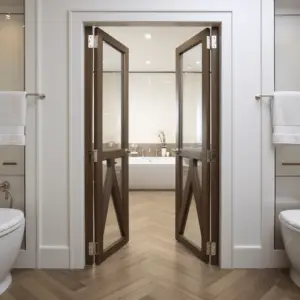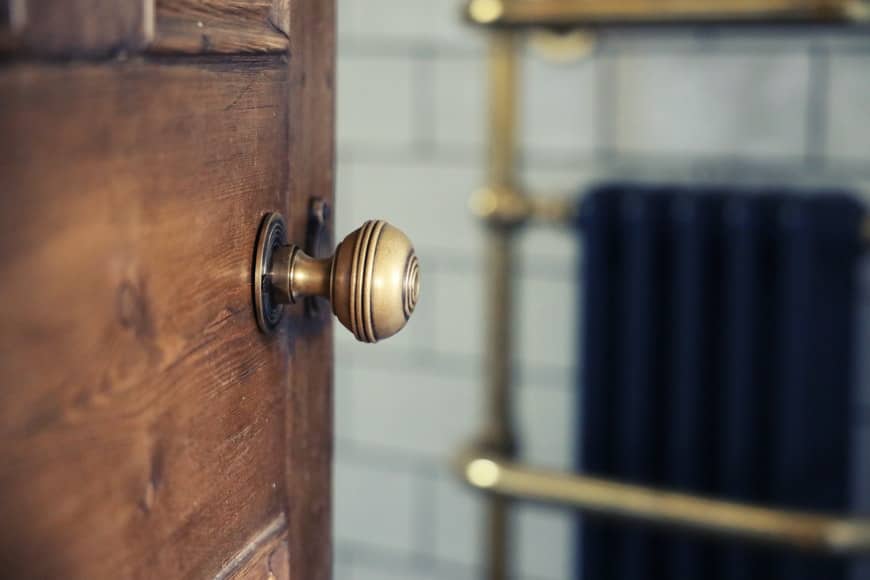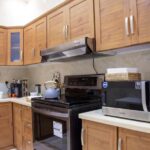Yes, bathroom doors can and do swing outwards depending on the situation.
For starters, if you are looking to answer the question” Can bathroom doors swing out?” then you are in the right place. Already we have confirmed that, indeed, bathroom doors can swing outwards.
However, a lot goes into determining whether a bathroom door should turn inward or outward. Our next section explores the clear difference between your bathroom door swinging outward or inwards. Even better to learn the clear advantages of each door swing direction and understand what aspects determine the door swing. Let’s get into it.
Table of Contents
Bathroom Door Swing Direction

In particular, all swing doors, inward or outward, will help control the bathroom odor and prevent your whole house from stinking up. Bathroom doors swinging outwards also create more space with the design, allowing more effortless movement within the bathroom. In short, you could count on an outward opening bathroom door not to get in the way of traffic within the bathroom area.
On the flip side, most bathroom doors you will come across swing inside due to several reasons. First, bathrooms are wet places, and with water flowing out, an outward opening door would only release more water.
In addition, bathroom doors swinging inwards can also be a move to save on space, especially where the door can get in the way of a hallway or staircase. Most importantly, the inward design saves you on open floor space with less cramping and crowding outside the bathroom.
Changing Bathroom Door From In-Swing to Out-swing
In any case, your bathroom space might be compromised by the way the door swings, especially if the design swings inwards. The process of fixing such a problem would be an easy-to-fix alternative to the door swing.
As such, reverse the hinges and turn the door to the opposite side of the inner area. Such a change would need locally available tools and expertise on bathroom door swings. But before anything else, always check your local building regulations for any restrictions on having bathroom doors swinging outward.
Tools You Will Need
Screw drill
Tape measure
Chisel flat
Pencil marker
Hammer
Finishing nails
How to make a bathroom door swing-out
Step 1
Start by removing the bathroom door by unscrewing the hinges from the jamb using the drill.
Record all measurements, including areas between
- The space between the top upper hinge and the top of the door jamb
- The space between the bottom of the door lower hinge and the bottom of the door jamb
- The distance between the door frame’s topside to the top of the middle bracket.
Step 2
Get rid of the door stops positioned on the sides plus the top of the door jamb. The door stops are marked as the thin molding trims that help stop door swings when closed.
In the real sense, these door stops also frame the door itself by covering gaps between the door structure and the doorjamb. Get the chisel to lay flat against the door jamb and slightly tap it under the door stops using the hammer. Gently pry them away from the wall and set them apart.
Step 3
Next, move to prep the frame by checking how the door swings.
You can do this by standing outside the room and aligning the door hinge to the other jamb side. The hinges should also have the pin sides facing away from the bathroom. Test out the hinges by maneuvering them open and closing them to recap how the bathroom door will swing.
Step 4
Get your previous door measurements and use the tape measure to transfer the dimensions of the door hinges to the doorjamb’s opposite side. Use the pencil marker to mark each location of the top, middle, and bottom hinges.
Step 5
Align each hinge to its new marked position while placing them in a closed and flat position against the door frame’s pencil markings. Remember each mounting plate of the hinge should have the outline trace onto the marking on the door jamb.
Step 6
Recess each hinge area by chiseling out the marked outline on the door jamb wood. Just be sure to use the sharp tip of the chisel to create hollowed cross-sectional cuts into the inside of the chiseled contours.
In total, four to five horizontal chisel cuts should be present within the bracket space from top to bottom. Chip away any extra wood and ensure the chisel cuts are smooth when done.
Step 7
Place each door bracket inside its corresponding recessed position and drill the pilot holes into the doorjamb to position the screws.
Step 8
Use the drill to screw in the hinges while lining up the holes onto the screw marks. Drill each screw into the doorjamb
Step 9
Get the door in a closed position and align the strike plate to the door latch and the doorjamb. Mark the doorjamb on the strike plate with the markings on the top and bottom. Also, mark the hole where you will drill and fit the latch into the doorjamb.
Step 10
Get a 3/4-inch boring bit and drill two vertical holes to create an oval opening.

Step 11
Get the strike plate and place it over the bored hole. Screw-in the strike plate into the doorjamb and ensure it’s steady enough
Step 12
Align the stop flush molding against the door, leaving a slight gap for movement. Be sure first to close the door while also having the doorknob latched to the doorjamb. In conclusion, the door stops will have changed the swing direction with both stops, plus the door turned from the original swing direction.
Step 13
Get a hammer with a couple of finishing nails to close off the job. Use the hammer to tap both the side and top sections of the door stops inside the jamb using the necessary number of finishing nails.
Step 14
Double-check all sections are secure and that the door swings when opening and closing
The Wrap Up
So in any case, you can answer,” Can bathroom doors swing out?”. Yes, indeed they do. The key, of course, is always to plan and get it right when it comes to your bathroom door dimensions plus components.
Once you get the initial phase right, you will have your new door installation working in no time.


